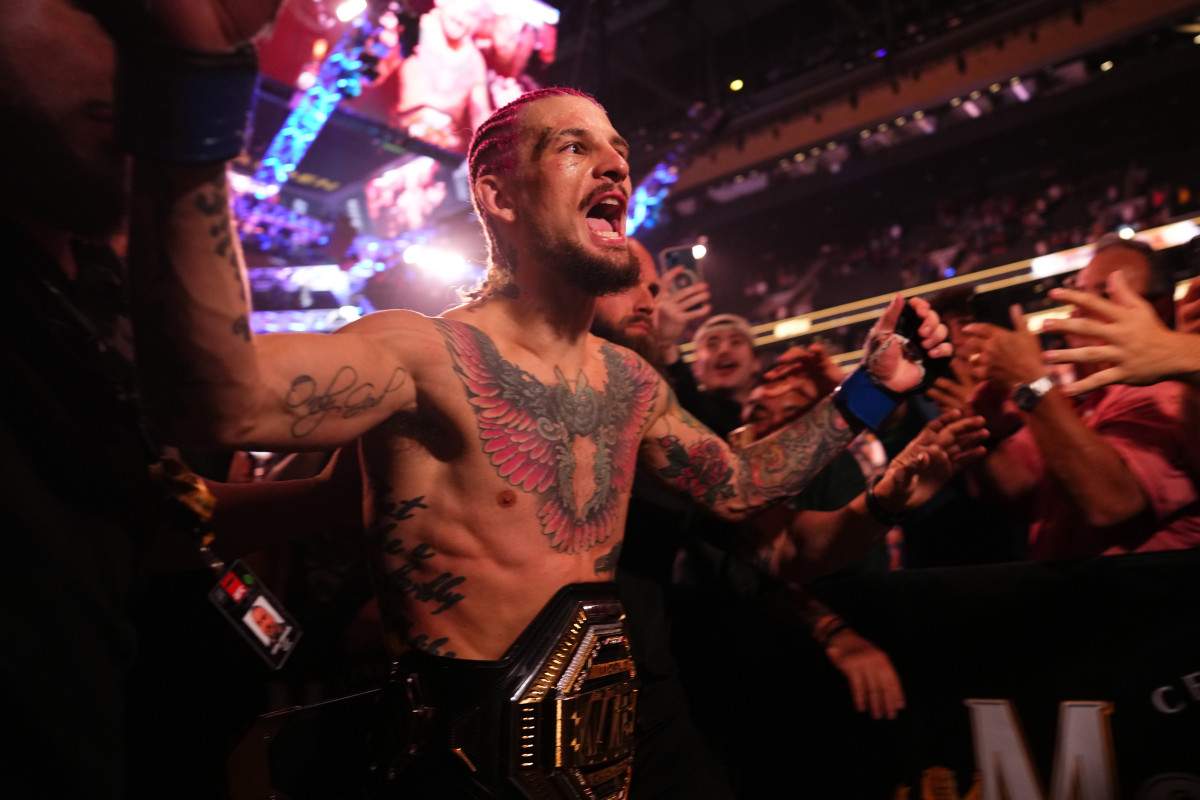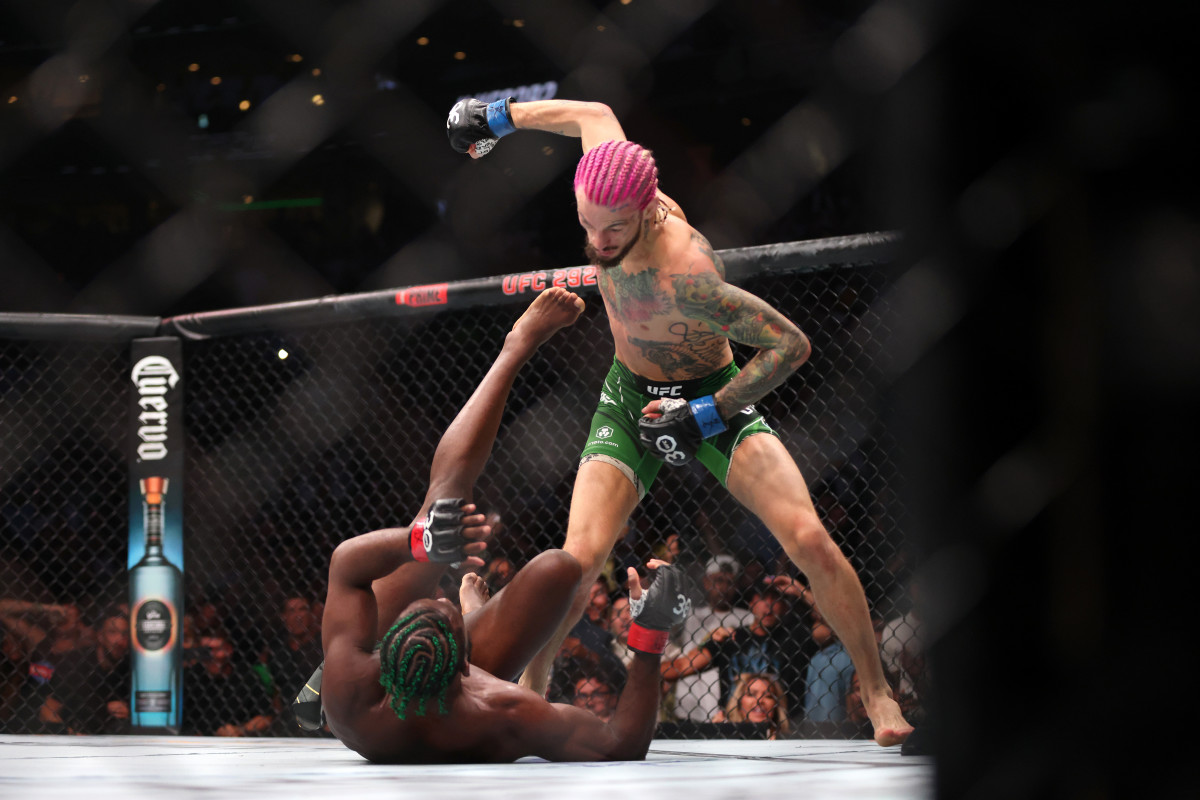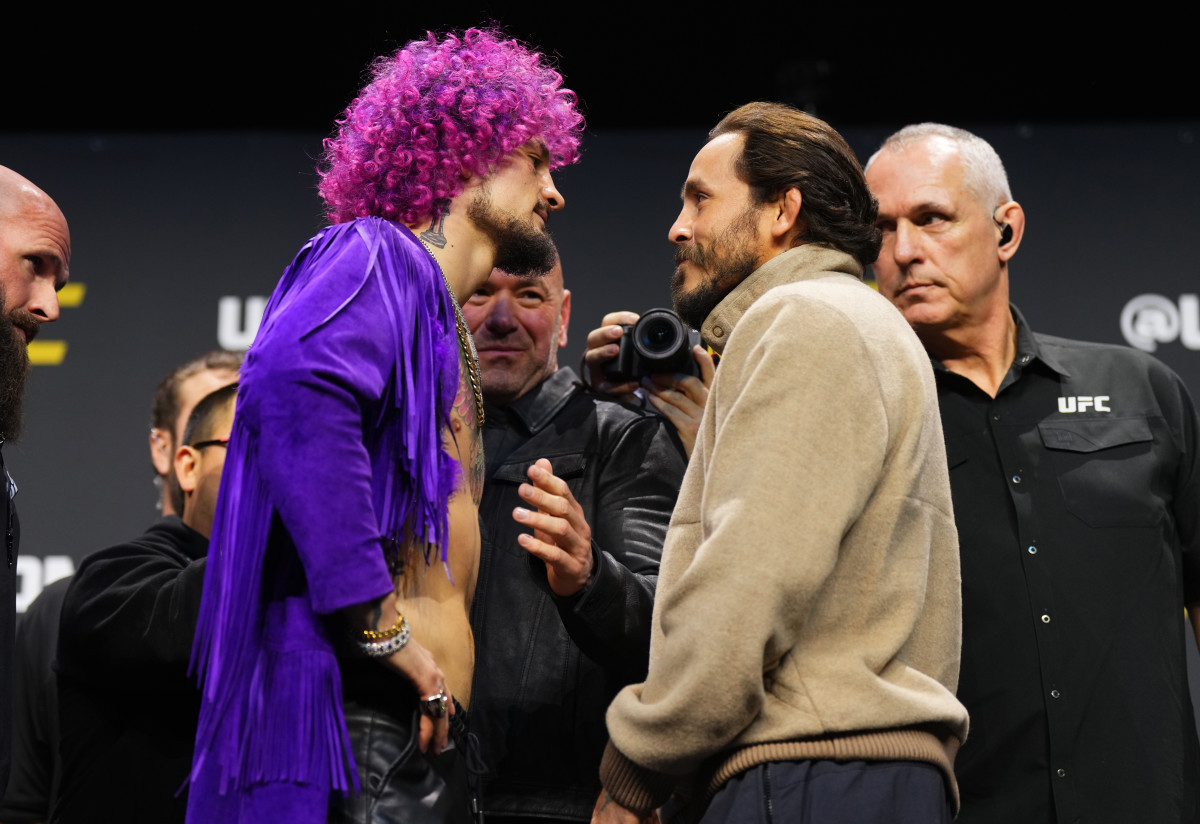Sean O’Malley Says He Is Ready for His Moment

It is preferable to the alternative. If you’re going to suffer in a mixed martial arts fight—and odds are good, you are—better to do so as the beater, and not the beatee. So it was that, back in September, when Sean “Suga” O’Malley talked offhandedly of his “pretty serious” hand injuries, describing a forthcoming MRI the way you and I might describe picking up milk at the store, he was quick to note the source. “It’s from where I was hammer-fisting him.”
More specifically, on Aug. 19 in Boston, O’Malley blasted his opponent, Aljamain Sterling, then the UFC bantamweight champ (at least for a few more seconds) with his specialty punch, a right hand, cocked quickly and deployed with murderous intent. The punch connected. Sterling fell to the canvas. O’Malley pounced. In less time than it will take you to read this sentence, O’Malley unleashed a barrage of fists that collided violently with various parts of Sterling’s face. By the time the referee mercifully stepped in to stop the fight, the UFC didn’t just have a new 135-pound belt-wearer on its hands; it had a new star.

You can teach MMA fighters how to kick and punch and choke, and as O’Malley does so expertly (more on this later) defend the takedown. But it’s harder to impose lessons about the thermodynamics of celebrity. You either get it or you don’t. With a personality as relentlessly colorful as his rainbow hair … with a full complement of tattoos, some of them etched on his face … with a wry sense of humor … with an openness about his personal life (it is a rare celebrity whose Wikipedia bio notes that he “is currently in an open relationship with his wife) ... with an ability to back it up with his reliably electric performances in the cage … Well, consolidate it all, and you are left with a figure who exudes star wattage, perhaps more than any MMA fighter since Conor McGregor.
The UFC recognizes this. The promotion, starting with chieftain Dana White, has made no secret of the promotion’s fondness for this 29-year-old chromatic, pay-per-view goosing star from Montana. O’Malley was fast-tracked to a title fight. He is well-promoted. He is well-paid. Usually guarded with its intellectual property, the UFC put clips of his knockout of Sterling on social media and then made the entire fight available on YouTube. Subtext: we will release this footage now, chumming the waters for the next fight, the next episode in the Suga show.
That episode has now arrived: On Saturday night, O’Malley will defend his bantamweight belt against Ecuador’s Marlon “Chito” Vera at UFC 299 in Miami. The fight is a rematch of their August 2020 bout, when Vera handed O’Malley his only UFC loss.
O’Malley is well aware of his moment. “When you feel, it’s my time, it’s a good feeling,” he says. “Like, you call the shots.” There are all manner of shots awaiting, as well as challengers calling, aware that simply sharing the Octagon with him will boost their profile and finances. There are endorsement opportunities. There are alleged movie roles. There is a lure, an increasingly popular one in MMA, of putting on shoes and bigger gloves and taking a pay-per-view boxing fight.
But the first order of business: Vera.

In so many sports, origin stories often start with material desperation, athletes seeking to deliver themselves (and their families) from poverty and despair through excellence with a ball and stick. In MMA, so many stories start with an existential desperation or emotional hole in need of a center.
There was nothing especially remarkable about Sean O’Malley’s childhood in Helena, Montana. The middle of four children, he was the son of a nurse (mom) and a police detective (dad). There wasn’t deprivation, but there wasn’t luxury either. “I definitely didn't grow up broke or rich,” he says. “But money was the number one thing we all fought about in the family. We don't go out to eat, and if we do, we need to get something off the dollar menu.”
There was nothing especially remarkable about O’Malley’s upbringing. But that was the issue. He didn’t particularly take to school. He didn’t show much interest in becoming another generation of law enforcement. He was a fine athlete in sports like baseball, football and basketball, but as a skinny kid, under 6-feet tall, he was unlikely to play beyond high school.
Then, when he was 16 (cue music), he walked into the local kickboxing gym. He was seized first by the place, and then by the sport. He could bring his athleticism and flexibility to bear, and picked up nuances with alarming speed. He enjoyed matching skill and will with other fighters. In candid moments—as if he has any other kind—he admits that there was a rush that accompanied knocking out an opponent, and imposing his physical will on another human being. “I just knew this is what I was meant to be doing.”
An unruly mop of thick curly sometimes trailing behind him like a rudder, he would snap kicks or throw punches that drew whistles from onlookers. His coach nicknamed him “Suga,” a nod to his sweet technique.
Mom was something less than thrilled. Dad was happy that at least his son had found something that gave him fulfillment. O’Malley blazed through the martial arts belt system and when, predictably, he transitioned to MMA, he used kickboxing as his base. Though he had never wrestled in school, he picked up the ground game and jiu-jitsu. Soon, he was in the MMA equivalent of minor league baseball, pinballing across Montana and the Great Plains fighting in small promotions, invariably giving worse than he got.
O’Malley didn’t so much have a pivotal fight as he had a pivotal moment. It came in his 19th summer when he met Tim Welch, a former fighter from Montana who had opened a gym in Phoenix. A friend encouraged O’Malley to train at Welch’s gym and match up against pros. “I got very humbled,” he says “I realized I was not nearly as good as I thought I was. I was not the man like I was in Montana.” Welch figured he’d never see O’Malley again.
But the kid was seduced by the gym, the iron-sharpens-iron competitiveness. He also wanted to keep training with Welch, a jiu-jitsu black belt, who combines old school manners with cutting edge techniques, from red-light therapy to yoga poses. O’Malley went back to Montana and began working at a home for mentally disabled adults. When he saved $2,000, he went back to Phoenix, this time with designs for staying longer. That was almost a decade ago. He’s never left.
He began rising in the MMA ranks, fighting on increasingly bigger cards. Naturally rangy, he seldom struggled to make weight. For a natural kickboxer he won plenty of fights with his feet and hands; but, on account of his ground training under Welch, sometimes by submission as well.

In 2017, O’Malley was 7-0 as a pro when he appeared on Dana White’s Contender Series. In his fight against Alfred Khashakyan, he brutalized his opponent with a straight right, a walk-off knockout. Providing Manning-cast-style commentary, Snoop Dogg lost his mind—“Three piece dinner with biscuits, O’MALLEY!” The one-two combination of the kid with the salad hair throwing a lights-out punch and Snoop going crazy made for a viral moment. Walking past White backstage, O’Malley smiled, “Welcome to the Suga Show.” White rewarded him with a contract on the spot.
O’Malley kept winning, often spectacularly. And he kept entertaining. He was a regular on MMA podcasts. A vocal advocate for legalizing marijuana, in one interview he smoked a joint while hitting pads. He applied tattoos to his skin as if they were liniment. As he once explained his strategy to ESPN, “I'm stupid enough to get a tattoo on my face. But I'm smart enough to get a fake one to see if I like it first.”
There were some setbacks along the way. In a fight against Andre Soukhamthath, O’Malley won by decision but broke his foot and didn’t fight again for another year. In 2019, he was popped for a doping violation when the banned substance Ostarine appeared in his urine sample. He says he still has no idea how it entered his system. The United States Anti-Doping Agency (USADA) effectively agreed, ultimately ruling O’Malley’s sample was consistent with unintentional use. Still, he switched his diet to vegan in part to eliminate variables and avoid another positive test. When he returned from a six-month suspension, it was to face Vera. Early in the fight, O’Malley caught a kick at a freak angle. Rendered immobile, O’Malley was mauled by Vera for a TKO.
After that fight, O’Malley says he began working on his takedown defense, hardly the sexiest discipline but an essential skill for a top fighter (especially for one who didn’t wrestle in high school). And he amped up the Suga Show, launching his own YouTube Channel, adding tattoos to his body and face. And speaking about his open relationship with Danya Gonzalez, the mother of their daughter—“my little Princess”—Elena, now three. Here’s how O’Malley explained it recently on TimboSugarShow, the podcast he hosts with his coach: “We’re good, for now. Marriage when it was first introduced is when peoples’ life expectancy was 21 years old, it was so f***ing low, it was rare. So you were only married for a few years. Now, you have people that are married for 40, 50, 60 years.”
The Sterling fight marked the biggest opportunity of O’Malley’s career. It wasn’t simply that a belt was in the balance. It was a win that would mute all talk that the UFC was, well, handling him with kid gloves and stage-crafting his rise and diet of opponents. “Definitely the most nervous I ever was before a fight.”
His camp was not exactly filled with encouraging omens. The month before the fight, he injured his ribs. As a result, he eliminated wrestling from his training and sparring. Then during the weight cut to get down to 135 pounds, he woke up in the night to urinate and ran into a door, bruising his face. (O’Malley would later joke that if the worst injury you suffer the week of a fight comes from a door, you’re doing something right.)
On the night of the fight, with Danya looking on, O’Malley masked both his injuries and his fear. In Sterling’s previous fight, he took down his opponent Henry Cejudo, a former Olympic gold-medal wrestler, almost at will. When O’Malley fought Sterling he stuffed takedown attempt after takedown attempt. Keeping the fight on his feet, O’Malley saw his opening and unloaded the right hand. To quote Snoop Dogg: ka-boom.
O’Malley being O’Malley, he’s using his outsized personality as leverage. Now he has his rematch fight against Vera, a chance to avenge that freak result during the summer of COVID. But, he’s also lobbying to fight Gervonta Davis in a boxing ring, following the path Conor McGregor blazed when he fought Floyd Mayweather (and made more money from that one night of pay-per-view than he did in his entire UFC career.) “Most MMA fighters really don't know how to box,” O’Malley says. “But that's most MMA fighters. I clearly know how to throw a punch.”
And as long as he has the mic, Sean O’Malley, take us out: “I want to become a pay-per-view star. I want to make massive fights. I want to give people that feeling that, you know, Connor gave people when he fought Floyd. I want to give people that feeling that I gave them Aug. 19th in Boston [against Sterling]. That will be a moment people remember for the rest of their lives. It was insane. And that's what I'm in this sport to do.”
